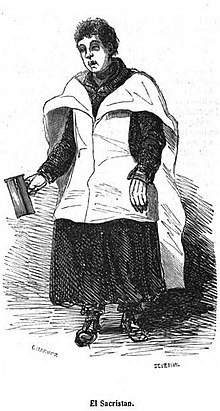Asacristanis an officer charged with care of thesacristy,thechurch,and their contents.

In ancient times, many duties of the sacrist were performed by the doorkeepers (ostiarii), and later by the treasurers and mansionarii.[1]TheDecretalsofGregory IX[2]speak of the sacristan as if he had an honourable office attached to a certainbenefice,and say that his duty was to care for the sacred vessels,vestments,lights, etc. Nowadays the sacristan is elected or appointed. TheCæremoniale Episcoporumprescribed that incathedraland collegiate churches the sacristan should be apriest,and describes his duties in regard to the sacristy, the BlessedEucharist,thebaptismal font,theholy oils,the sacredrelics,the decoration of the church for the different seasons and feasts, the preparation of what is necessary for the various ceremonies, the pregustation inpontificalMass,the ringing of the church bells, the preservation of order in the church, and the distribution of Masses; finally it suggests that one or twocanonsbe appointed each year to supervise the work of the sacrist and his assistants.
In theOld Testament,the office and duties of the sacristan are assigned to theLevites.1Chronicles23-26 describes howDavidassigned them duties such as temple doorkeepers, guardians, singers and musicians.
Custos
editThe under-sacristan is also mentioned in theDecretals.[3]He was the assistant of the sacristan, was subject to thearchdeaconand discharged duties very similar to those of the sacristan. By the early twentieth century, the office was hardly ever attached to a benefice and so usually a salaried position. TheCouncil of Trentdesired that according to the old canons,clericsshould hold such offices; but in most churches, on account of the difficulty or impossibility of obtaining clerics,laymenperform many of the duties of the sacristan and under-sacristan.
In some European medieval contexts, acustoswas given the more important roles of keeping the safety of the church, its relics, its treasure, and its archives, but was also responsible for the perception ofcapitationes,symbolic head-taxes that associated freemen with a religious institution.[4]
Altar societies
editAltar societies were once commonly organised within most Catholic parish churches. Member duties vary according to circumstances, and in some instances include tasks that ordinarily fall within the sacristan's province, such as the vestments and altar vessels, making ready for the priest's Mass. In general, they consist of the payment of yearly dues into a fund for maintenance and repair of accessories used in Church ceremonies, and usually also include a certain amount of labour for this purpose. Altar societies differ fromtabernacle societiesin that they work for the benefit of the church they are attached to while tabernacle societies work for the benefit of many different poor churches.
Eastern Churches
editIn theEastern Churches,the sacristan is known as theecclesiarch,particularly inmonasteries.In large monasteries he may be assigned an assistant known as theparaecclesiarch.An analogous office is that of theskeuophylax.In parishes, however, the sacristan is calledsexton.In addition to the tasks and responsibilities mentioned above, if an individual has a message for the priest while serving in the sanctuary, it is given to the sexton to give to the priest or deacon.
Academia
editMany Christian-faith schools appoint sacristans as members of theirprefectbodies, particularly inpublic schoolsand institutions founded on the English model. For instance, theUniversity of the Southin Sewanee, Tennessee, anEpiscopaluniversity, hosts a student Sacristans Guild. Sacristans aid the school's chaplain in the day-to-day running of the chapel and promotion of a Christian ethos in the school. In terms of seniority, they are often regarded as second only to theschool captains.[citation needed]
See also
editReferences
editCitations
edit- ^Epitome to Canon XIX, Council of Chalcedon, Christian Classics Ethereal Library
- ^lib. I, tit. xxvi, "De officio sacristæ"
- ^lib. I, tit. xxvii, "De Officio custodis"
- ^Kupper, Jean-Louis (2017). "Du chevage et de la ministérialité en Hesbaye". In Dierkens, Alain; Schroeder, Nicolas; Wilkin, Alexis (eds.).Penser la paysannerie médiévale, un défi impossible?(in French). Editions de la Sorbonne. pp. 278, 280 & 302.ISBN979-10-351-0017-9.
Sources
edit- Goggin, John Francis; Kelly, Blanche Mary (1912)..In Herbermann, Charles (ed.).Catholic Encyclopedia.Vol. 13. New York: Robert Appleton Company.
External links
edit- Media related toSacristansat Wikimedia Commons
- The dictionary definition ofsacristanat Wiktionary